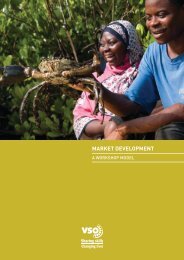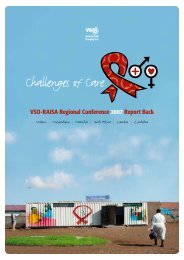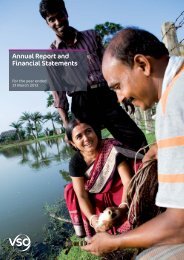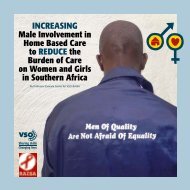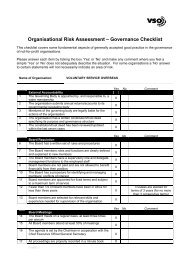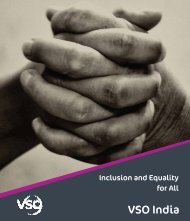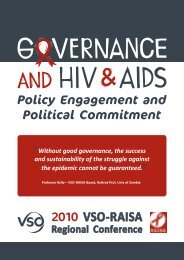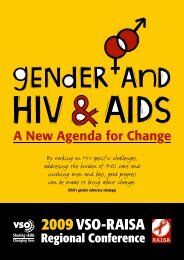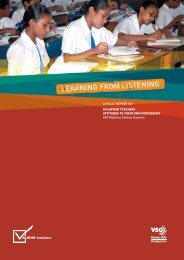Walking the Talk - VSO
Walking the Talk - VSO
Walking the Talk - VSO
You also want an ePaper? Increase the reach of your titles
YUMPU automatically turns print PDFs into web optimized ePapers that Google loves.
Prevention, treatment and care and supportIn every aspect of prevention, treatment and care and support, women and girls are regularly unable toexercise <strong>the</strong>ir rights to access HIV and AIDS services. In this report we detail <strong>the</strong> barriers for women andgirls in terms of prevention, treatment and care and support, and suggest recommendations. We summarise<strong>the</strong>se recommendations below.Prevention“…my husband tested positive before me,but my aunties, toge<strong>the</strong>r with my latehusband, disapproved of condom use,arguing that he had paid up all <strong>the</strong> bridewealth and <strong>the</strong>refore [I] was supposed notto deny him sex, unprotected or not… <strong>the</strong>yaccused condom use with lack of love formy late husband… everyone was againstme and [I] had no option…”Strategies to prevent HIV infection often fail to take intoaccount <strong>the</strong> real lives of women and girls. Preventionstrategies based on abstinence, being faithful and usinga condom ignore <strong>the</strong> lack of control most women haveover <strong>the</strong>ir sexuality and <strong>the</strong> violence women face,particularly within marriage. The development ofprevention methods that women can control (femalecondoms and microbicides) will help, as will educationand public awareness campaigns that promotewomen’s rights.National and donor governments must only fundevidence-based, gender-sensitive preventionprogrammes that take a rights-based approach,including contributing <strong>the</strong>ir fair share to <strong>the</strong>development of microbicides and increasing access to<strong>the</strong> female condom and o<strong>the</strong>r female-initiated HIVpreventionmethods.TreatmentZimbabwean woman living with HIV and AIDS“How can I get up at 3am <strong>the</strong>n travel aloneduring <strong>the</strong> night to make sure I getantiretrovirals? But a man can easily walkduring <strong>the</strong> night.”Women are more likely to receive treatment than men, butour research suggests <strong>the</strong>y may be less likely to adhere toit. Reasons given are <strong>the</strong> lack of privacy and <strong>the</strong> fear ofviolence or abandonment if <strong>the</strong>ir positive status isdiscovered. Women also have less access to adequatenutrition, which <strong>the</strong>y need to support <strong>the</strong>ir treatment. Ifaccess to treatment is to be increased, <strong>the</strong> particularbarriers for women will also have to be addressed.National governments must develop, fund andimplement <strong>the</strong>ir national treatment plans and budgetswith a strong emphasis on <strong>the</strong> access and adherenceof women and girls to treatment, particularly those inpoor and rural communities.Care and support“We walk for miles and miles in order toreach clients in o<strong>the</strong>r homesteads. Oncewe are <strong>the</strong>re clients expect a lot from us,like food and even money. This putspressure on our personal resources.”Namibian care providerWomen living with HIV and AIDS face significantbarriers in getting <strong>the</strong> care and support <strong>the</strong>y need.Leadership of support groups is often dominated bymen, with women and girls unable to raise <strong>the</strong>irconcerns. The problem is particularly difficult forwomen living in poverty, who don’t have access to <strong>the</strong>income generation opportunities or state services <strong>the</strong>yneed to provide for <strong>the</strong>mselves or <strong>the</strong>ir families.Fur<strong>the</strong>rmore, women and girls are <strong>the</strong> major careproviders, yet <strong>the</strong>y are seldom paid and <strong>the</strong> value ofthis work is rarely recognised.Rwandan woman living with HIV and AIDS<strong>Walking</strong> <strong>the</strong> talk putting women's rights at <strong>the</strong> heart of <strong>the</strong> HIV and AIDS response 7




